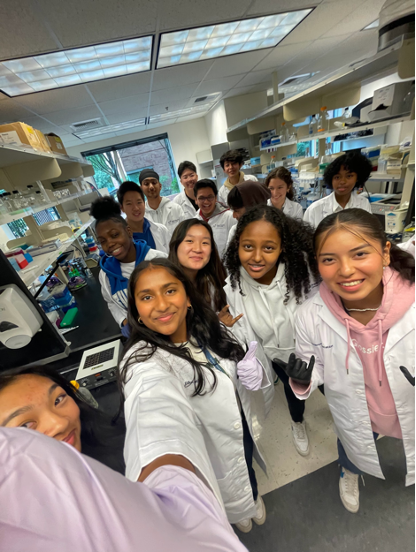Emma Nguyen
- SEP

- Sep 17, 2023
- 3 min read
Over my 2 week experience at Fred Hutch I had the amazing opportunity to work in the lab to explore what gel electrophoresis and CRISPR Cas9 are and how they help in diagnosing and treating cancer. I also had the opportunity to learn more in depth about the immune system, cancer in general and how CAR T cell treatment can be very helpful in sending numerous cancer patients with acute and chronic leukemia but focusing especially on ALL (acute lymphoblastic leukemia) into remission. In the program we did many hands-on things like performing our own tests with DNA samples and learning the technique and importance of micropipetting. Aside from our work in the lab, we were also able to tour many different labs at the Hutch, including Dr. Moens zebrafish lab and Dr. Parkhurst’s fruit fly lab.

Results from my groups CML lab where we determined if our patient had this CML cancer from blood samples
In Dr. Moens lab, we saw thousands of zebrafish in a room that was able to perfectly accommodate all their needs, how they are kept healthy, and can be successfully bred. I learned how scientists use these fish in order to conduct research for how genes control early brain development. It was the very first time I saw a live embryo of any animal as we were able to view the zebrafish embryos in microscopes. We were able to see the very first few stages and got to guess which stage they were in. Everyone in the lab was very dedicated in ensuring that the fish were happy and healthy to ensure that their research was of the best quality and conditions.

Zebrafish embryo from Google
Another lab that we toured is Dr. Parkhurst’s fruit fly lab. I learned that fruit flies have similar genes to us humans. Because of this, the people in Dr. Parkhurst’s lab wound the flies with a small laser to study their healing habits to try and understand how our bodies heal and how something could go wrong in that process creating other diseases like cancer. I also learned that fruit flies heal very quickly in comparison to humans which makes it more convenient to study how they heal. Everyone in the labs made me feel very welcomed as they were eager to answer all of our questions and very open to what we had to say.
When heading into the Hutch, I was very excited to be able to meet new people and I was pleasantly surprised that all the faculty members were also very excited to meet me and my peers. Even if they weren’t a part of the Science Education Program, they were still all equally open minded and welcoming which made my whole experience so much better. I was impressed to see how all across campus there are so many people from so many different backgrounds and ages doing science and it made me feel like I could definitely work there in the future. I also found myself in awe of how many people that are in the sciences also have hobbies in very different things such as the fine arts, like myself. I am so grateful that I was given this opportunity to learn more about the scientific research field and deepen my understanding of all the different cancer treatments and what it’s like to work behind the scenes in finding a cure. I will remember this experience forever and all the new people I got to make and have new connections with.

A photo of me and the other members in my cohort (Session 1 2023)






Comments